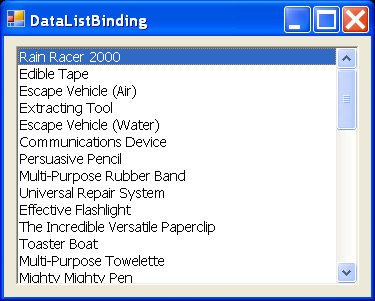Data ListBox Binding 3

/*
User Interfaces in C#: Windows Forms and Custom Controls
by Matthew MacDonald
Publisher: Apress
ISBN: 1590590457
*/
using System;
using System.Drawing;
using System.Collections;
using System.ComponentModel;
using System.Windows.Forms;
using System.Data;
namespace ADO.NET_Binding
{
/// <summary>
/// Summary description for DataListBinding.
/// </summary>
public class DataListBinding : System.Windows.Forms.Form
{
internal System.Windows.Forms.ListBox lstName;
/// <summary>
/// Required designer variable.
/// </summary>
private System.ComponentModel.Container components = null;
public DataListBinding()
{
//
// Required for Windows Form Designer support
//
InitializeComponent();
//
// TODO: Add any constructor code after InitializeComponent call
//
}
/// <summary>
/// Clean up any resources being used.
/// </summary>
protected override void Dispose( bool disposing )
{
if( disposing )
{
if(components != null)
{
components.Dispose();
}
}
base.Dispose( disposing );
}
#region Windows Form Designer generated code
/// <summary>
/// Required method for Designer support - do not modify
/// the contents of this method with the code editor.
/// </summary>
private void InitializeComponent()
{
this.lstName = new System.Windows.Forms.ListBox();
this.SuspendLayout();
//
// lstName
//
this.lstName.Anchor = (((System.Windows.Forms.AnchorStyles.Top | System.Windows.Forms.AnchorStyles.Bottom)
| System.Windows.Forms.AnchorStyles.Left)
| System.Windows.Forms.AnchorStyles.Right);
this.lstName.IntegralHeight = false;
this.lstName.Location = new System.Drawing.Point(8, 8);
this.lstName.Name = "lstName";
this.lstName.Size = new System.Drawing.Size(232, 184);
this.lstName.TabIndex = 1;
//
// DataListBinding
//
this.AutoScaleBaseSize = new System.Drawing.Size(5, 14);
this.ClientSize = new System.Drawing.Size(248, 202);
this.Controls.AddRange(new System.Windows.Forms.Control[] {
this.lstName});
this.Font = new System.Drawing.Font("Tahoma", 8.25F, System.Drawing.FontStyle.Regular, System.Drawing.GraphicsUnit.Point, ((System.Byte)(0)));
this.Name = "DataListBinding";
this.Text = "DataListBinding";
this.Load += new System.EventHandler(this.DataListBinding_Load);
this.ResumeLayout(false);
}
#endregion
private void DataListBinding_Load(object sender, System.EventArgs e)
{
DataSet dsStore = new DataSet();
dsStore.ReadXmlSchema(Application.StartupPath + "\\store.xsd");
dsStore.ReadXml(Application.StartupPath + "\\store.xml");
lstName.DataSource = dsStore.Tables["Products"];
lstName.DisplayMember = "ModelName";
}
[STAThread]
static void Main()
{
Application.Run(new DataListBinding());
}
}
}
 ADO.NETBinding.zip( 76 k)
ADO.NETBinding.zip( 76 k)Related examples in the same category